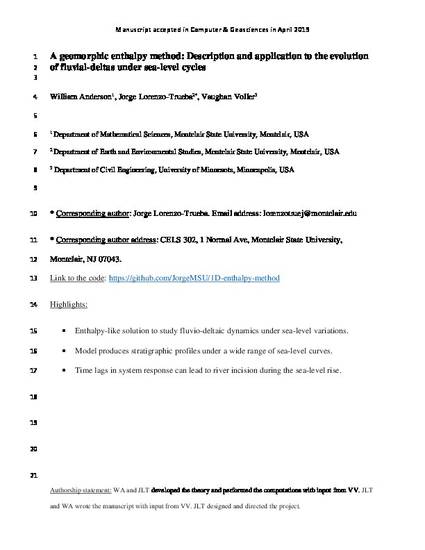
Article
A geomorphic enthalpy method: Description and application to the evolution of fluvial-deltas under sea-level cycles
Computer & Geosciences
(2019)
Abstract
Fluvial deltas are composites of two primary sedimentary environments: a depositional fluvial region and an offshore region. The fluvial region is defined by two geomorphic moving boundaries: an alluvial-bedrock transition (ABT), which separates the sediment prism from the non-erodible bedrock basement, and the shoreline (SH), where the delta meets the ocean. The trajectories of these boundaries in time and space define the evolution of the shape of the sedimentary prism, and are often used as stratigraphic indicators, particularly in seismic studies, of changes in relative sea level and the identification of stratigraphic sequences. In order to better understand the relative role of sea-level variations, sediment supply, and basin geometry on the evolution of the ABT and SH, we develop a forward stratigraphic model that accounts for curvature changes of the fluvial surface and treats the SH and ABT as moving boundaries (i.e., internal boundaries that are not known a priori and their location must be calculated as part of the solution to the overall problem). This forward model extends a numerical technique from heat transfer (i.e., enthalpy method), previously applied to the evolution of sedimentary basins, to account for sea-level variations, including eustatic sea-level cycles. In general, model results demonstrate the importance of the dynamics of the fluvial surface on the system response under a large range of input parameter values. Specifically, model results suggest that time lags in the ABT response during sea-level cycles can result in geologically long-lived river incision in the upper and mid portions of the fluvial surface during sea-level rise. These results suggest that the relationship between the coastal onlap configuration of strata and relative changes in sea level is complex, and therefore not necessarily a good indicator of contemporaneous sea-level changes.
Keywords
- Enthalpy method,
- Fluvial deltas,
- sea-level cycles,
- Alluvial-basement transition,
- Shoreline,
- river incision
Disciplines
Publication Date
Spring September 1, 2019
DOI
https://doi.org/10.1016/j.cageo.2019.05.006
Citation Information
William Anderson, Jorge Lorenzo Trueba and Vaughan Voller. "A geomorphic enthalpy method: Description and application to the evolution of fluvial-deltas under sea-level cycles" Computer & Geosciences Vol. 130 (2019) p. 1 - 10 Available at: http://works.bepress.com/jorge-lorenzotrueba/6/
